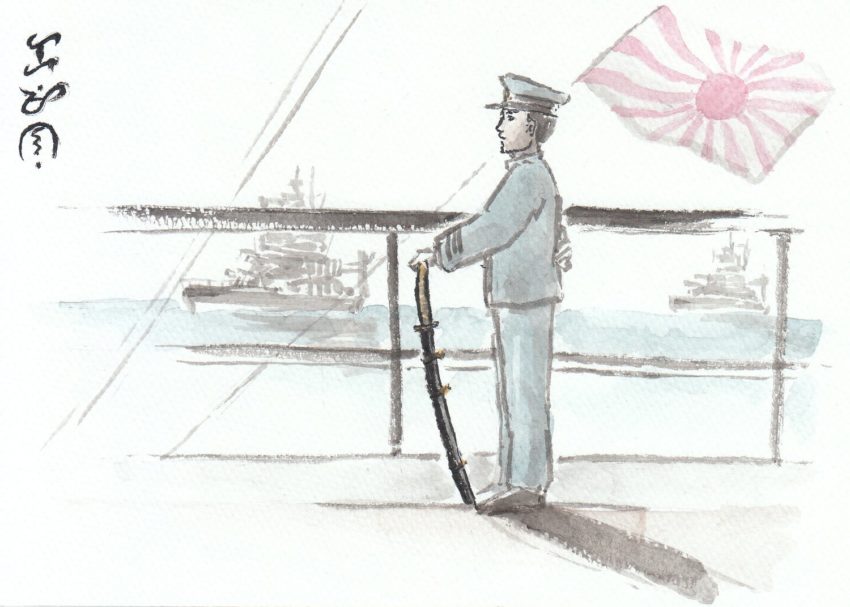Japan’s military used one of several blades, depending on the branch. While the Army used the guntoGUNTO 軍刀 "(modern) saber" learn more..., the Navy’s version was called a kaiguntoKAIGUNTO 海軍刀 "Navy military sword" learn more.... This article will go into great detail about various aspects of this particular piece of foreign militaria from the East. The area of Japanese naval swords is a lesser-explored area, and is all the more interesting for it.
How Different Does Adding kai Make a Weapon?
The word gunto literally means “military sword” and is used to describe mass-produced blades that were made by machines instead of by the skilled hands of a swordsmith. This production method also means that, with the exception of a handful of specific examples, all Japanese naval swords are made of stainless steel. They were called kaigunto to draw a distinction between Japan’s armed forces on the land and on the seas. To be clear, the term kai (“sea” in English) can be used for several water-related things, like shell and ocean. Literally, a kaigunto is an “ocean military sword.”
Basics of the Kaigunto and Naval Dirk
Another interesting tidbit relevant to dating these blades is that all kaigunto are considered shinguntoSHINGUNTO 新軍刀 "new military sword" learn more..., i.e. “new military swords,” because they were produced during the time frame of 1935 to 1945. What makes these WW2 Japanese swords “new” arises from a surge in Japanese nationalism and the pursuit of a new weapon that better exemplified the spirit of Japan. As such, shingunto designs are modeled after a Kamakura Era tachiTACHI 太刀 "great sword" learn more..., a cavalry blade.
Gunto created before 1935 were known as kyuguntoKYUGUNTO 旧軍刀 "old military sword" learn more..., or “old military swords.” Kyugunto were used by all of Japan’s armed forces, some even appearing until the end of World War II. This, despite the fact that their heydays had been the Russo-Japanese and Sino-Japanese Wars.
Physical Characteristics of Naval Kyugunto
Naval kyugunto are distinct from army and cavalry blades because there is no side piece along their backstrap. One distinction between a naval kyugunto and a kaigunto is that the kyugunto has a hand guard like you’d see on a cutlass or saber.
Owing to their owners’ aquatic base of operations, the sayaSAYA 鞘 "scabbard/sheath" learn more... of Japanese naval swords was sometimes wrapped with rayskin. In cases where rayskin was used on the saya, the kaigunto’s tsukaTSUKA 柄 "handle or hilt" learn more... will be given the same treatment. The two main sources of kaigunto would be the Tenshozan Tanrenjo in Kanagawa Prefecture, and the Toyokawa Naval Arsenal. The Tenshozan Tanrenjo was also known to produce dirks for the Navy.
While the bulk majority of kaigunto bear no ornamentation, some sport an anchor, which may or may not be encircled. Any blade produced by the Tenshozan Tanrenjo would also feature their logo along the nakago, the unexposed portion of the tang where the grip surrounds. Any gunto that bears a sakura (cherry blossom) marker is not a kaigunto. The cherry blossom was a symbol of the Japanese Imperial Army; the kaigunto used anchor symbols due to the obvious connection to watercraft.
Japanese Naval Swords Design Types
There were two major designs of kaigunto:
- Type 94 – These were made in 1934 and feature traditional hilts, with a rayskin same and silk ito. Scabbards were metallic objects lined with wood.
- Type 98 – This variation came about in 1938 and is basically a simpler version of the Type 94. This was likely due to there being fewer resources when compared to four years earlier. The “largest” mark of distinction between early Type 98s and Type 94s would be the lack of a second hanging point on the scabbard. As World War II progressed, more and more changes would be made to the Type 98’s design. Painted wooden scabbards replaced metal scabbards as metal had become increasingly precious. The growing dearth of metal also meant that many Type 98 Japanese naval swords were either fitted with cheap brass ornamentation or no ornamentation at all. The last few kaigunto of 1945 were shadows of their forebears of 1938. These were fitted with nothing better than cheap copper, brass or fire-blackened iron. “Tassels” consisted of wire and low-grade ito in brown, green or tan color.
In addition to these main types, one more military sword deserves mention here just so you can be as clear as possible:
- Type 95 (not a naval sword!) – This iteration, first produced in 1935, is mentioned here only to note that it was designed as a Type 94 for non-commissioned officers (NCOs) in the army and cavalry. As all kaigunto were made for officers and never for NCOs, a type 95 kaigunto would be a contradiction in terms.
Information Specifically Regarding Naval Dirks
Dirks (small daggers) for the officers of Japan’s Imperial Navy first came onto the scene in the 1880s. The pattern behind these backup weapons changed little afterwards and was even seen as the model for the kind used by civilians. The basic officer’s naval dirk was a machined piece that would have its blade plated with chrome. The handle would be wrapped with white rayskin and wire and mounted with brass. The best way to distinguish a Naval dirk from a civilian one would be from its engravings and emblems along the mount.
There are a handful of accounts of naval dirks that housed a hand-forged blade. These instances would be specially ordered, with the mountings being custom-built to accommodate the “ancestor” steel. Some of these dirks can be traced back to the signatures of the Tenshozan Tanrenjo.
Ownership, Merit and Use of Japanese Naval Swords
Like all shingunto, kaigunto were seen as badges of rank and were common among naval officers. While non-commissioned officers received their own gunto, they were neither shingunto nor kaigunto. The rank of the bearer was signified by the color of tassels that went through a loop at the hilt’s end. The tassels of all ranks below admiral were brown. Some shingunto swords were a mixture of contemporary handles and blades that were hand-forged centuries earlier. In these latter cases, the blade was likely an heirloom.
The kaigunto was significant not only of its bearer’s rank but also of some of the values that Japan continues to espouse to this day:
- Might – As an island nation, the only way Japan had to deal with a foreign power was by leaving the ground. While Japan’s navy was nothing to sneeze at, the kamikazeKAMIKAZE 神風 "divine wind" learn more... pilots that deployed from carriers were also a major offensive asset.
- Unity – A group of people can achieve greater successes than any one man by his lonesome.
- Tradition – As an island nation with a history of occupying other countries, Japan had more than a little experience in fighting from the seas.
While kaigunto were certainly regarded as part of an officer’s uniform, it seems that they were not just for show during a parade. Common naval strategy during World War II was to engage from a distance for the first two days, then close in to charge on the third day. Accounts of officers using the blades in melee are hard to find due to just how much Japan loved its battleships and also funding their development into truly impressive weapons.
Collecting Japanese Naval Swords
Kaigunto are still somewhat popular among sword collectors these days. It does not take much work for someone with an interest in this particular class of sword to find one. Beware, however, that some outlets fail to properly do their research and will ignorantly refer to them by names like samurai swords or even katanas. Kaigunto ceased production with the end of World War II and all nihontoNIHONTO 日本刀 "Japanese sword" learn more... (Japanese swords) were either destroyed or preserved as works of art within museums. The bulk of the kaigunto that survived made it into the hands of foreign servicemen involved in the Pacific Theater.
A sad fact of life is that fewer and fewer people who served in World War II are still around. Some of these aforementioned servicemen may have handed their spoils of war down to their children, grandchildren, or even great-grandchildren. Others may have decided to return their Japanese naval swords to the families of the officers these weapons belonged to. This means that a market exists for people interested in acquiring a kaigunto. Your new naval blade may come from the descendants of someone who claimed it during service in World War II, or from someone who acquired it through a pawn shop, estate sale, auction or possibly a private transaction.
However you acquire a naval sword from Japan, you can be proud of delving into a fascinating and relatively obscure sub-section of Japan sword beauty and art.

